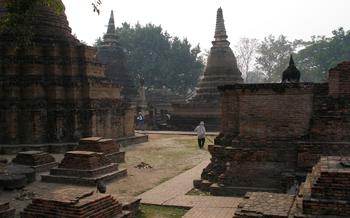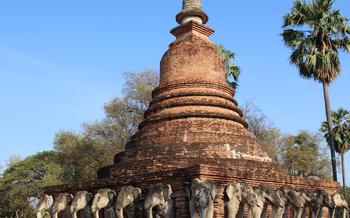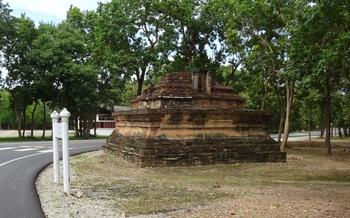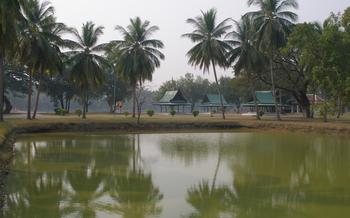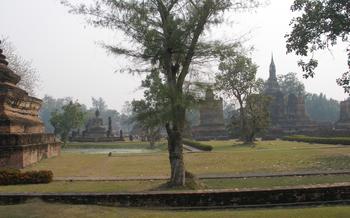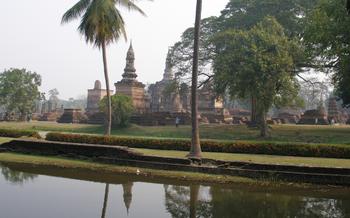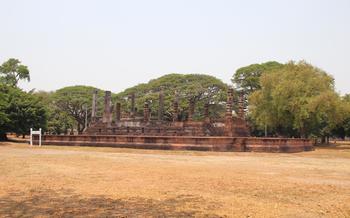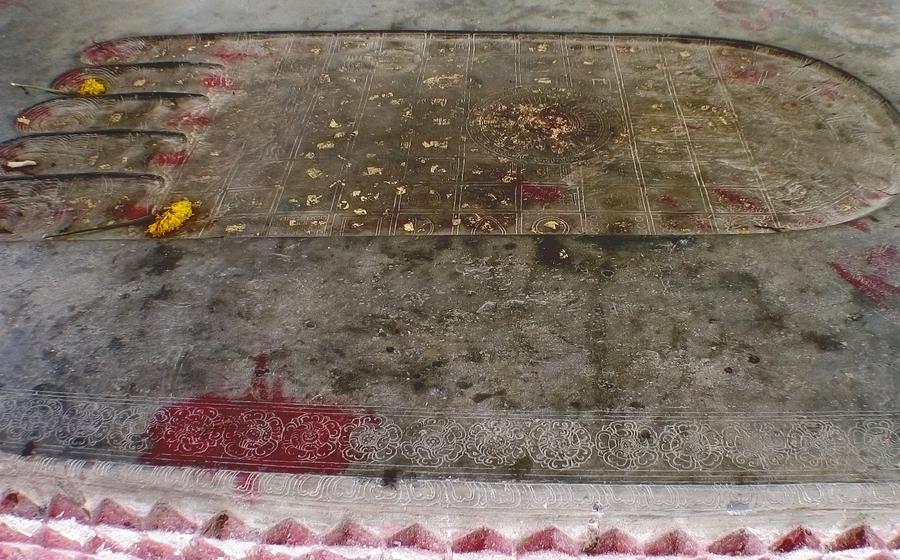
Wat Trapang Thong
- Architectural Features
- Reclining Buddha Image
- Pagodas and Stupas
- Surrounding Grounds
- Nearby Attractions
- Getting There
- Visitor Etiquette
- Cultural Significance
- Restoration Efforts
- Local Cuisine
- Insider Tip: Unveiling the Hidden Gem of Wat Trapang Thong
Architectural Features
Wat Trapang Thong stands out for its unique architectural features that showcase the artistic and religious traditions of the Sukhothai period. The temple's centerpiece is its large mondop (ordination hall), which serves as a sacred space for religious ceremonies and rituals. The mondop's most striking feature is its stepped roof design, a characteristic element of Sukhothai architecture. The roof rises in a series of gradually diminishing tiers, creating a visually appealing and distinctive form. This stepped roof design not only adds aesthetic value but also serves a practical purpose, allowing for proper water drainage during the rainy season.
The temple's exterior is adorned with intricate stucco decorations and sculptures that depict various scenes from Buddhist mythology and history. These intricate carvings showcase the craftsmanship and artistic skills of the Sukhothai artisans. The stucco decorations include floral motifs, celestial beings, and scenes from the life of Buddha, adding a layer of visual interest and religious significance to the temple's architecture. The combination of the stepped roof design and the intricate stucco decorations creates a harmonious and visually stunning architectural masterpiece that reflects the artistic heritage of the Sukhothai Kingdom.
Reclining Buddha Image
At the heart of Wat Trapang Thong lies an awe-inspiring reclining Buddha image, a testament to the artistry and devotion of the Sukhothai era. Measuring an impressive 15 meters in length, this colossal sandstone sculpture exudes an aura of serenity and tranquility. The Buddha's serene countenance, with its half-closed eyes and gentle smile, invites visitors to contemplate the impermanence of life and the path to enlightenment.
The reclining posture of the Buddha holds deep cultural and religious significance in Buddhism. It represents the Buddha's final moments on earth, as he lay down on his right side and entered Parinibbana, the ultimate state of nirvana. This posture symbolizes the Buddha's complete detachment from worldly desires and his attainment of the highest level of spiritual liberation.
Legends and stories surround this magnificent Buddha image, adding to its mystical allure. One tale tells of a young monk who, while meditating in front of the statue, experienced a profound spiritual awakening that led him to become a renowned teacher of Buddhism. Another legend speaks of a miraculous event where the Buddha image emitted a brilliant light that illuminated the entire temple grounds, inspiring awe and devotion among the faithful.
Pagodas and Stupas
Within the sacred grounds of Wat Trapang Thong, visitors will encounter an array of pagodas and stupas, each possessing unique architectural styles and profound symbolic significance. The pagodas, with their towering spires reaching towards the heavens, represent the Buddha's path to enlightenment and his ultimate victory over worldly desires. Their intricate designs and decorative elements reflect the artistry and devotion of the ancient craftsmen who meticulously created them.
The stupas, on the other hand, serve as symbolic representations of the Buddha's relics or remains. These hemispherical structures, often adorned with intricate carvings and sculptures, embody the impermanence of life and the ultimate goal of achieving nirvana. The presence of these pagodas and stupas within Wat Trapang Thong not only adds to the temple's visual splendor but also reinforces its profound spiritual significance.
Surrounding Grounds
The serene and tranquil surroundings of Wat Trapang Thong add to its spiritual and historical charm. Visitors can stroll through the lush gardens, where colorful flowers bloom amidst the ancient ruins, creating a harmonious blend of nature and history. The temple grounds are dotted with tranquil ponds, where visitors can sit and relax, listening to the gentle sound of water and the birdsong. Notable trees, such as the majestic Bodhi tree, considered sacred in Buddhism, provide shade and a sense of peace. The overall ambiance of the temple grounds is one of tranquility and serenity, allowing visitors to escape the hustle and bustle of everyday life and connect with the spiritual essence of the temple.
Nearby Attractions
After exploring the serene beauty of Wat Trapang Thong, visitors can venture further to discover other captivating historical sites in the vicinity. The Sukhothai Historical Park, a UNESCO World Heritage Site, is a must-visit destination, showcasing the grandeur of ancient Sukhothai. Within the park, visitors can admire the impressive ruins of Wat Mahathat, the former royal temple, and Wat Sri Chum, renowned for its colossal seated Buddha image. These sites offer a glimpse into the rich history and cultural heritage of the Sukhothai Kingdom.
For a comprehensive exploration, start your journey at Wat Mahathat, the heart of the ancient city. Marvel at the remnants of the towering prang (main spire) and the intricate carvings adorning the temple walls. Continue to Wat Sri Chum, where the massive seated Buddha image exudes an aura of serenity and devotion. Finally, return to Wat Trapang Thong to witness the sunset, casting a warm glow on the temple's silhouette, a perfect ending to a day of historical exploration.
Getting There
Wat Trapang Thong is conveniently located just a short distance from the center of Sukhothai city, making it easy to visit for both independent travelers and organized tour groups. To get to the temple, you can opt for various transportation options depending on your preferences and budget.
One of the most popular and affordable ways to reach Wat Trapang Thong is by tuk-tuk, a three-wheeled motorized rickshaw that is widely available in Sukhothai. Tuk-tuk rides are typically inexpensive and can be negotiated with the driver based on the distance and duration of the journey.
Alternatively, you can hire a taxi for a more comfortable and direct ride to the temple. Taxis are readily available at the Sukhothai Airport, bus station, and various hotels and guesthouses in the city. The fare for a taxi ride to Wat Trapang Thong should be around 100-150 baht, depending on the distance and traffic conditions.
For those who prefer a more active and eco-friendly option, renting a bicycle is an excellent way to explore Sukhothai and visit Wat Trapang Thong at your own pace. Several bike rental shops are located in the city center, offering a range of bicycles, including mountain bikes and city bikes, for rent. The cost of renting a bicycle typically ranges from 50 to 100 baht per day.
Once you reach Wat Trapang Thong, you will find a spacious parking area where you can safely leave your vehicle or bicycle. From the parking area, it is a short walk to the temple grounds, where you can begin your exploration of this ancient and sacred site.
Visitor Etiquette
When visiting Wat Trapang Thong, it is essential to be mindful of the temple's sacred nature and show respect for the local customs and traditions. Visitors should dress appropriately, avoiding revealing or overly casual clothing. It is customary to remove shoes before entering the temple grounds and to walk around quietly and respectfully. Silence is encouraged within the temple complex, as it is a place of meditation and reflection. Visitors should be mindful of their behavior and avoid any actions that may be disruptive or disrespectful to other visitors or the monks residing at the temple. It is also important to refrain from touching or climbing on any of the Buddha images or other sacred objects within the temple grounds. By observing proper etiquette, visitors can help preserve the sanctity of Wat Trapang Thong and ensure a peaceful and respectful experience for all.
Cultural Significance
Beyond its religious significance, Wat Trapang Thong holds immense cultural value for the local community. The temple serves as a gathering place for villagers, who come together for various cultural and social activities. Throughout the year, the temple hosts festivals and events that celebrate Thai traditions and customs. These events often feature traditional music, dance performances, and food stalls.
One of the most significant festivals held at Wat Trapang Thong is the annual Songkran Festival, also known as the Thai New Year. During this festival, locals gather at the temple to participate in water-throwing rituals, which symbolize cleansing and renewal. The temple grounds come alive with laughter, music, and the joyous spirit of the festival.
Wat Trapang Thong also plays a crucial role in preserving and transmitting traditional knowledge and skills. The temple is home to a small library that houses ancient manuscripts and texts on Buddhism, history, and traditional Thai arts. These manuscripts are carefully preserved and studied by monks and scholars, ensuring that traditional knowledge is passed down to future generations.
The cultural significance of Wat Trapang Thong extends beyond its boundaries, as it represents the rich cultural heritage of Sukhothai. The temple is a living testament to the artistry, spirituality, and traditions of the Thai people. Visitors to Wat Trapang Thong can immerse themselves in the local culture, experience the vibrant festivals, and gain a deeper understanding of Thai history and traditions.
Restoration Efforts
Wat Trapang Thong and other historical sites in Sukhothai have undergone extensive restoration efforts to preserve their cultural heritage. The Fine Arts Department of Thailand, along with international organizations such as UNESCO, have played a crucial role in these endeavors. Their meticulous work involves careful cleaning, repairs, and reconstruction, using traditional techniques and materials to maintain the authenticity of the structures.
These restoration efforts are essential in protecting Thailand's rich history and cultural legacy. By preserving these ancient sites, future generations can continue to appreciate the architectural brilliance and religious significance of Wat Trapang Thong and other historical treasures in Sukhothai. Visitors can contribute to these efforts by supporting organizations involved in the restoration work, either through donations or volunteer opportunities. Together, we can ensure that these priceless heritage sites remain a source of pride and inspiration for generations to come.
Local Cuisine
Sukhothai offers a diverse culinary scene that blends traditional Thai flavors with regional specialties. After exploring Wat Trapang Thong, take a culinary journey and indulge in the local delights. For a taste of authentic Thai cuisine, head to the street food stalls near the temple. Savor the aromatic flavors of pad thai, a stir-fried noodle dish with vegetables, eggs, and your choice of protein. Try the khao soi, a rich and flavorful curry noodle soup with crispy egg noodles and tender chicken or beef. For a refreshing treat, try the mango sticky rice, a classic Thai dessert made with sweet mangoes and glutinous rice. Don't miss the opportunity to sample the local fruits, such as the sweet and juicy rambutans or the tangy tamarinds. Embrace the culinary experiences that Sukhothai has to offer and create lasting memories of your visit.
Insider Tip: Unveiling the Hidden Gem of Wat Trapang Thong
Amidst the grandeur of Wat Trapang Thong's main attractions, there lies a hidden gem waiting to be discovered by curious explorers. Tucked away in a serene corner of the temple grounds, visitors can find a secluded meditation spot that offers a tranquil retreat from the bustling crowds. Surrounded by lush greenery and the gentle sound of birdsong, this hidden sanctuary invites visitors to pause, reflect, and connect with their inner selves. Whether you're seeking a moment of solitude or a deeper spiritual connection, this secret spot within Wat Trapang Thong is a treasure waiting to be unearthed.
